Einleitung
Ersetze den alternden Core Duo Prozessor deines mini durch einen leistungsstarken Core 2 Duo.
Was du brauchst
-
-
Schalte deinen Mac Mini aus, trenne alle Kabel und drehe ihn um.
-
Führe den Jimmy in den Spalt zwischen dem oberen Aluminiumgehäuse und dem unteren Kunststoffgehäuse ein.
-
Der Jimmy sollte nach ungefähr 9,5 mm stoppen.
-
-
-
Biege den Jimmy vorsichtig nach außen, um den Spalt ein wenig weiterzu öffnen, und hebe das untere Gehäuse ein wenig an.
Patience is your best friend.
Do not insert “jimmy in too far. Marking a line from tip upwards on the tool will prevent too far insertion, possibly breaking tabs or damaging internal components.
To prevent the cover closing back up, small strips of matchbook cover (os equivalent) can be inserted about half inch hold prevent closure.
-
-
-
Wenn du die erste Seite gelöst hast, drehe den Mac Mini und beginne, an der Vorderkante zu hebeln.
-
Biege mit der gleichen Hebelbewegung die Clips nach innen und hebe das untere Gehäuse aus dem oberen Gehäuse heraus.
-
-
-
Möglicherweise musst du den Jimmy an der Kante entlang bewegen, um alle Clips zu lPosen. Sei geduldig und arbeite dich schrittweise vor.
-
-
-
Drehe den Mac Mini wieder auf die Vorderseite und hebe das obere Gehäuse vom unterem Gehäuse ab.
-
-
-
Drücke die beiden Stifte zusammen, und hebe die AirPort-Antenne von ihrem Befestigungsstift ab.
-
-
-
Hebe den Sicherungsbügel am ZIF-Anschluss auf der linken Seite mit der Spudgerspitze ein wenig hoch.
Good catch of the incomplete unlocking instructions. ;P
Hmmm... what if I didn't read this before and I removed the cable and the lock sort of broke?... what would happen... would I experience problems? I can still put the cable back in place and push the lock back down with the spudger.
Same. I totally removed the lock , the edges are busted and won't stay in place, How can I get the cable to stay? what's the fix?
Suzanne -
Dan O & Suzanne, hold the cable in the socket and put a dab of hot glue on both sides, It's non-conductive and should hold...worked for me.
does any one know, where to get the connector from zhe ZIF Cable?
someone, that preowned my mac broke the holder!
Julian, did you ever find where to get a replacement lock for the Zip Cable. Mine is also broken..
Suzanne -
This is not my first memory replacement in a Mini and I got over-confident and stupidly fully removed the audio cable ZIF lock and assumed I had broken something. But, now that I have read this guide more carefully, I am not sure. I sure would love to hear some detailed instructions for putting a ZIF lock back on.
Is it possible that I have removed it without having broken it? If I have broken it, do I have to buy a new cable? Just a new ZIF lock? A new audio board? This is a 2.0 GHz A1176.
Thanks!
Michael, Mine seems to be broken. I bought & tried the Kapton Tape that was suggested & still no sound.
Suzanne -
-
-
-
Hebe das Audio-Flachbandkabel nach oben aus seinem Anschluss heraus.
As an option to avoid potential damage when disconnecting the cable from the ZIF socket and clip, it is possible to unscrew the audio board and remove it along with the internal frame.
-
-
-
Hebe den Stecker am Kabel des Thermosensors der Festplatte mit einer Pinzette aus seinem Anschluss auf dem Logic Board heraus.
I've had to remove a few of these connectors on iBooks and other small Apple devices ... I've found that, with careful and gentle pressure (working first one side and then the other) using a small flat-headed jeweller's screwdriver is best.
I agree Mike.
-
-
-
Eine der Kreuzschlitzschrauben liegt vertieft in der Nähe der Einschalttaste. Drehe sie heraus.
-
-
-
-
Eine weitere Kreuzschlitzschraube, die den Rahmen am Gehäuseunterteil befestigt, sitzt vertieft in der Nähe der Statusanzeige. Drehe sie heraus.
-
-
-
Entferne die Kreuzschlitzschraube in der Nähe der Bluetooth-Antenne vom inneren Rahmen.
Before removing any of these screws, there is another step needed which is not here:
On the front of the optical drive, right side as you look at the slot-load, is a small blue board attached by a single black screw. This needs to be removed before the optical drive can be taken out.
-
-
-
Entferne die Kreuzschlitzschraube, mit der der innere Rahmen in der Nähe der Audioanschlüsse am Untergehäuse befestigt ist.
-
-
-
Hebe den inneren Rahmen behutsam vom Gehäuseunterteil ab, beachte, dass sich die AirPort-Antenne und andere Kabel verfangen könnten.
At this point be careful that you don't pull out the Airport antenna ... but if you do, just check that it is back before re-assembling.
During re-assembly, the internal frame has to go in at an angle ... the back of the optical drive goes in first.
This means that you can seat the fan cover correctly, but more importantly, there is an interconnect board on the back of the optical drive that must be firmly pushed back into its housing on the logic board.
If, like me, you pull the wire on the airport antenna free, it snaps back into place easily. The connector is on the extra card screwed to the motherboard that looks like it has a phone battery embedded in it. The connector is at the top of the 'battery'. This accessory card is the wifi card, so it makes sense that the antenna plugs onto this.
-
-
-
Fasse den Stecker am Kabel zur Einschalttaste fest mit der Pinzette an und hebe ihn senkrecht nach oben vom Logic Board weg.
-
-
-
Fasse den Stecker am Kabel zur Statusanzeige fest mit der Pinzette an und hebe ihn senkrecht nach oben vom Logic Board weg.
-
-
-
Entferne die einzelne Torx T10 Schraube, mit der das Logic Board am Gehäuseunterteil befestigt ist.
-
-
-
Hebe mit dem flachen Ende eines Spudgers das Ende des Logic Boards bei der PRAM Batterie leicht an.
-
-
-
Hebe das lose Ende des Logic Boards vorsichtig an und wackele es ein bisschen hin und her, wenn du es von den I/O-Anschlüssen wegziehst.
Hi, when re-assembling, if you find resistance to the board sliding right up to the rear panel make sure that the spring finger on the casing goes over the power connector not inside it. It fits much better that way!
-
-
-
Der Kühlkörper wird durch einen Kunststoffstift mit Feder in jeder Ecke gegen die Oberfläche des Prozessors gedrückt.
Be careful to not break the nylon pins during removal or insertion. The strength of the spring can break the barbed end off the pin.
Also, be sure to orient the heat sink in the right direction when putting it back. The fins should allow air to flow towards the openings at the back of the Mini (where the ports are).
-
-
-
Drücke einen der Stifte, die den Kühlkörper festhalten, mit einem geeigneten Kunststoffwerkzeug nach unten. Du wirst einen leichten Widerstand der Feder unter dem Stift spüren.
-
Halte den Stift am Logic Board auf der Seite mit dem Kühlkörper nach unten gedrückt und drücke gleichzeitig mit der anderen Hand die Widerhaken des Stifts auf der Unterseite in den Schaft des Stifts hinein.
-
Halte beide Widerhaken zusammengedrückt und drücke den Stift durch das Loch im Logic Board heraus.
-
Wiederhole dieses Verfahren, bis alle Stifte am Kühlkörper vom Logic Board gelöst sind.
I busted the little expansion fins on 2 of the four plastic connectors here. I was gentle, but they are brittle buggers. Heads up.
Oh, and then I busted the other two trying to put them back in! They are 3+ years old, and seem to break quite easily. I looked from nylon fasters at the hardware store, but couldn't find small enough ones. I had some small stainless fasteners, and made sure they were only touching the grounded material. I don't know if I recommend it, but all is well for me. I kept the spring in, and just put a washer a nut to hold the spring down. Try to do the operation in a small room so when the posts and springs go flying, you don't have many square feet to cover to find them. I spent a good portion of the upgrade time crawling around on the floor looking for a lost spring...
The springs holding the nylon pins are stronger than you might think.
Use the finest tip needle-nose pliers you can find. The trick is compressing *and* pushing at the same time.
Around 2mm or so from the surface of the circuit board is the furthest point at which the barbs can be compressed sufficiently to pass through the hole in the board.
If you grasp the barbs closer to the circuit board, you won't easily be able to push the pin through the board.
Adding to my note, the illustration for Step 21 is a bit misleading. You'll have to grab the barbs much closer to the end of the pin than is shown here.
I also broke one of the winged pins and replaced it with 4-40 Nylon machine screws and brass nuts I bought from McMaster-Carr. They are #94605A115 and #95130A110 respectively. Also, to press on the pins while squeezing the wings while holding onto the board is a challenge. I found a removable eraser from a mechanical pencil works great to press as it fits down into the heat sink just enough to be self stabilizing so one had presses and holds while the other just deals with the wings.
Thanks for those McMaster-Carr item numbers!
I was just giving my ancient Mac mini a much-needed deep cleaning and re-greasing, and broke two of these posts, sending one of the springs across the room - whoops!
Replacements on the way...
Do yourself a favor and just accept the fact that these little buggers WILL break and that you will need to find replacement nylon screws and bolts. A quick google shopping search for "Mac Mini Nylon Screws 4-40 X 3/4" should pull up what you need -- I found an ebay listing for $3.99 USD!
Even if you somehow manage to keep the pins intact during this step, realize that getting the heat sink back on is an even harder task in my opinion.
I found it easier to have another individual assist here -- one to securely push down the pin on one side and the other to firmly grip and squeeze the barbs. Don't underestimate the strength of the springs. The pin and spring can go flying if either end is not secured properly.
Mechanical pencil eraser does work perfectly to press pins. Let's you control the board and the pin with one hand while manipulating the barbs with the other. I found that a straight hemostat worked really well in place of pliers. Squeeze the barbs as near to the end as you can, then push them into the hole until they're wedged. Use your fingers or a spudger to push them the rest of the way through so you don't endanger the logic board with a metal tool. Got all four of mine out and back in intact, all in about five minutes. If the barbs don't break off, there is no danger of the pins flying because of the spring -- they are captive on the heatsink.
I came across some heatsink push pins in the Farnell catalog and tried them. Wish I hadn't bothered - although they are *just* about long enough, I only managed to get one to connect, the other three just refused to lock. Getting M3 bolts from ebay. Hope I haven't broken the CPU / PCB in the efforts to get the push pins in.
Hi, I managed to do this by just using fine, flat ended pliers to squeeze the barbs. I went end on to the pin head instead of from the side. Didn’t need to press on the heat sink side at all. A slight wiggle and the spring just pulled them through. Dead easy and didn’t break one on a 7 year old machine!
I didn’t break a pin, but I managed to knock a resistor (R4150) off the board, and then promptly lose it while trying to reattach it. Hopefully it’s not actually vital, as some parts aren’t … (Later: Boots fine, seems to run fine, with the new CPU. So whatever R4150 does, it’s not *100% obviously, immediately necessary*.)
A screwdriver bit set I got years ago from some Chinese web shop had the perfect tools for this: a screwdriver shaft that was thin enough to push the pins, and what appears to be a 2.5mm hex nut driver for the other side. Just pushing the pin into the 2.5mm slot and wiggling for a second or two did the trick. (I don’t know if that’s any standard size, but it was labeled M 2.5 and the opening seems to be approximately 2.5mm. The 3.0mm bit was too large for this purpose.)
-
-
-
Hebe den Kühlkörper vom Prozessor ab und lege ihn auf die Airport-Karte.
When I got to this step, I had trouble pulling up the heat sink. I even double and triple check to see if anything was holding it down. I used force but was able to get the heat sink out. The CPU was attached to the heat sink and the CPU was still in the lock position . It looked like there wasn't enough thermal paste and the CPU sealed itself to the heat sink. I was able to scrape off the CPU from the heat sink using the iSesamo to gently pry around the perimeter. When the CPU was off there was residue on the heat sink that I was able to clean off with a razor blade. Before placing the heat sink on top of the new CPU, I did do the "tinting" process to make sure the sticking wouldn't happen again. Not that I want to open up this box again!
-
-
-
Drücke den Stecker am Kabel des Thermosensors mit der Spudgerspitze aus seinem Anschluss heraus.
-
Entferne den Kühlkörper und lege ihn beiseite.
This connector is actually a "locking" connector - the small slot in the middle of the jack (visible in the picture) is where a protrusion on the plug actually "locks" the plug in place. One may need to use a small / thin flat blade screwdriver inserted against the top of the plug to gently pry the jack housing up while at the same time pushing the plug down and sliding the plug out. I realized this after breaking the plug following the listed instructions...
.
Better yet - this step and step 30 should really just be eliminated - there isn't any reason to unplug the sensor - its not in the way of changing out the processor.
Agree with “just leave the sensor connected”. There’s no need to remove it.
-
-
-
Nimm einen kleinen Schlitzschraubendreher und drehe die Prozessorsicherung um 180° gegen den Uhrzeigersinn, bis die Anzeige auf das "Offen"-Symbol gerichtet ist.
-
-
-
Fasse den Prozessor an den Kanten und hebe ihn senkrecht aus dem Sockel heraus.
-
-
-
Um den Prozessor genau auszurichten befindet sich am Prozessor und am Sockel ein kleiner Pfeil. (rot markiert).
-
Richte den Chip so aus, dass der Pfeil in der oberen rechten Ecke mit dem Pfeil in der oberen rechten Ecke des Sockels übereinstimmt.
-
Drücke den Prozessor behutsam herunter in den Sockel.
-
Beachte: wenn du von einem Core Solo oder Core Duo Prozessor auf einen Core 2 Duo Prozessor aufrüstest und später Lion (oder nachfolgende Betriebssysteme) verwenden willst, musst du die versteckte Datei /System/Library/CoreServices/PlatformSupport.plist nach dem Upgrade löschen.
-
-
-
Nimm einen kleinen Schlitzschraubendreher und drehe die Prozessorsicherung um 180° im Uhrzeigersinn, bis die Anzeige auf das "Geschlossen"-Symbol gerichtet ist.
-
-
-
Nun ist der Prozessor an seinem Platz und du kannst dich mit dem Kühlkörper beschäftigen.
-
Apple verwendet einen Wärmeleitfilm. Dieser muss entfernt werden, bevor der Kühlkörper befestigt werden kann.
-
Beseitige den Wärmeleitfilm mit einer Rasierklinge (oder einem anderen geeigneten Werkzeug, z.B. einer Kreditkarte) vom Kühlkörper.
-
Reinige alle noch vorhandene Spuren des Wärmeleitfilms mit etwas Alkohol.
-
Lasse den Kühlkörper gut trocknen, bevor du weiterarbeitest.
-
-
-
Trage eine dünne Schicht von Wärmeleitpaste auf die glänzende Siliziumoberfläche des Prozessors auf.
-
Genaue Hinweise, wie Wärmeleitpaste verwendet wird, findest du in unserer Anleitung.
-
-
-
Lege den Kühlkörper auf die Airport-Karte ab und schließe den Stecker des Thermosensors mit Hilfe eines Spudgers wieder an.
-
-
-
Drücke den Kühlkörper behutsam auf den Prozessor herunter.
Forget all the original plastic posts. I bought M3x20 (Sorry, I just know the measures of the "metric world" ;-)) plastic screws and according nuts in an ordinary DIY superstore. They fit perfectly. When fixing the heat sink it is recommended to get help from a second person. You should place the screws with springs from the upper side down through head sink and logic board with one hand while you simultaneously press on the heat sink on the processor. (Avoid canting it!) The helping person just tightens the nuts downside the logic board. Needless to explain that you should fix the screws diagonally.
You could probable get by with two small zip ties to hold it in place for each that break.
I got three of the nylon pins back in and the *last one* snapped part of the split end off. I just want to add a “me too” to the M3x20 nylon screw and hex nut solution. Re-use the spring and tighten to the same length as the original pins and you should be good to go. I did all four so I don’t have to re-live that ever again.
-
-
-
Halte den Kühlkörper an seiner Position fest und drücke gleichzeitig die vier Kunststoffstifte nach unten durch das Logic Board, um den Kühlkörper zu befestigen.
Hi, I found that a slight wiggle while pressing down helped the pins slip through the holes
I have watched a lot of you tube tutorials until i discovered this. This is the best instructional step-by-step so far. Excellent!
-
Um das Gerät wieder zusammenzubauen, musst du die Anleitung in umgekehrter Reihenfolge befolgen.
Um das Gerät wieder zusammenzubauen, musst du die Anleitung in umgekehrter Reihenfolge befolgen.
Rückgängig: Ich habe diese Anleitung nicht absolviert.
169 weitere Nutzer:innen haben diese Anleitung absolviert.
Besonderer Dank geht an diese Übersetzer:innen:
100%
Diese Übersetzer:innen helfen uns, die Welt zu reparieren! Wie kann ich mithelfen?
Hier starten ›
43 Kommentare
I'm learning from cpu-world.com that the Core Duo (and Core Solo) are 32-bit architecture, whereas the Core 2 Duo is a 64-bit design. Does this matter in any way?
Hi Richard. I realize this post is very old, but did you ever get an answer to your question as to whether the 64-bits of the Core 2 Duo Processor will be recognized/utilized in the 32-bit architecture of the Mac Mini A1176? Thanks, John
Hi. I'm afraid I can no longer answer the question "does it matter in any way", since I eventually upgraded to a new Mac Mini.
I can say that it didn't *seem* to matter, which means no software failed to run or performed noticeably poorly because of the upgrade. But I'm not especially performance sensitive, so it is possible that all/most/some software was running in 32-bit mode and not taking advantage of the higher throughput of a 64-bit architecture. The most CPU intense stuff I was running when I decided to upgrade was: Parallels running WinXP and some Windows-only legal software, along with Chrome with far too many tabs open, and iTunes. That proved to be too much, and it'd slow to a crawl too often. But I think the upgrade kept me on that iMac and extra two or three years, and was an interesting exercise.
Richard -
Hi, the processor will work just fine, but it’s recommended to do an EFI upgrade from 1,1 to 2,1, then you can run Lion and unofficially newer OSes
When going to all the trouble of replacing the CPU, a few other upgrades can be done at the same time:
- Upgrade RAM to 2GB maximum (required for OS X Lion), for example, Crucial CT541128
- Upgrade internal 2.5" SATA hard drive to larger size, and/or faster 7400 RPM or SDD.
- Replace PRAM battery with a fresh one (CR2032 lithium 3V)
What would be wise
This guide worked very well for me. Entire process took less than 90 minutes, and that was having to pull the upper frame a second time because I'd let the Airport antenna cable get snagged under the fan ductwork.
Thank you!
Without a spatula I resorted to a Pizza cutter. It worked perfectly as it has a bevelled edge and was easy to move across the side to loosen the clips.
Great idea - a pizza cutter worked great for me too!
pfbloom -
I too used M3 nylon screws and nylon nuts for the winged pins I broke during reassembly
I only got 30mm and cut it to about 20mm.
On the second A1176 where I removed the heat sink I didn't bother to remount the pins and used 4 nylon screws.
A special note: The second A1176 was much louder and got hot (fan running full speed) easily. When I removed the heat sink I found a die sized piece of plastic between the die and the thermal paste. Someone forgot to remove it when the Mini was assembled originally.
hello, core 2 duo model I can use to upgrade my mac mini
After upgrading to a Core 2 Duo (64-bit)
is it possible to install OS X 10.9 Mavericks ???
Exactly! Not seen an answer!
Hi! You actually can using SFOTT or MacPostFactor, but you’ll struggle to find a GPU driver (they do exist tho)
hi. Intel(R) Core(TM)2 CPU T5600 @ 1.83 Ghz may have the highest what Ghz number of
Mustafa -
Core 2 Duo T7600 (Merom) - 2.33 Ghz is the top of the range that will fit in a Mac Mini 1,1 or 2.1
There are two important points about which Core2Duo CPUs can be used:
1. socket 'M' (not 'P' or other variants sold with the same type)
2. FSB speed 166 MHz = 667 Mt/s (not faster or slower, as it can't be set in BIOS)
This leaves few choices (the 'T' and 'S' identifiers are on the upper label):
- T5500 / SL9SH or SLGFK or SL9U4 (all 1.66 GHz)
- T5600 / SL9SG or SL9U3 (both 1.83 GHz)
- T7200 / SL9SF (2 GHz)
- T7400 / SL9SE or SLGFJ (both 2.17 GHz)
- T7600[G] / SL9SD or SL9U5 (both 2.33 GHz)
The 'T7' ones are preferable because of 4 MB L2 cache (others offer 2 MB) - clock speed is less crucial.
I didn't test all CPUs, got data from spec lists.
Went through the process well, but when i got to booting my mac mini it did not display pictures. i went through the dismantle again and changed everything back to basics but still do not have anything besides a power on. help!!
Make sure you replace the PRAM battery, Macs with integrated graphics can lose video if this is flat/missing
Thanks Rob - it is always a good idea to replace this quite cheap but important battery when such a machine is opened once. They keep the internal clock holding time / date, and when this is faulty, some models even refuse to start up.
Thanks, completed the guide and it works brilliantly! 1.5 core solo to 1.83 core 2 duo.
I have mac mini 1.1 with 1.5 single core CPU in it. I was planning to upgrade to Core 2 Duo T7200 and from 512 to 2Gb ram. Do I have to flash EFI if I upgrade 2Gb and that processor or that flash is only if you want more than 2Gb ram ?
I have mac mini 1.1 with 1.5 single core CPU in it. I was planning to upgrade to Core 2 Duo T7200 and from 512 to 2Gb ram. Do I have to flash EFI if I upgrade 2Gb and that processor or that flash is only if you want more than 2Gb ram ?
Brilliant tutorial.... just upgraded core solo1.5 to core 2 duo 2.0. 30mins tops...
i've followed this guide and replaced CPU ram and hdd. I've switched the mac mini on and the system booted in few seconds, cpu and ram recognized. But after less than a minute it switched off by himself and I've never been able to switch it on again. No fan noise, no light, no chime, nothing. I have even tried to put the old cpu and ram back but no luck. It seems completely death. Any suggestion?
Were you able to get it working again?
hi there, can i put an intel t7500? or an intel t5450? wich one you recommend?
Careful - there is a chaos about different sockets (must be »M«), and the FSB speed must be the same as of the originally built-in processor.
Can anyone provide an answer as to which OSX system version you can upgrade to when upgrading the processor as described? What would be the latest version?
Dear I WOULD LIKE TO CHANGE THE CPU FROM T7600 2,20 gHZ with A T9500 INTEL 2.5 gHZ
who can tell me if it works??
thanks a lot to you all
I have this product: Apple Mac mini "Core 2 Duo" 2.0 features a 2.0 GHz Intel "Core 2 Duo" (T7200) processor,
a 4 MB on-chip level 2 cache, a 667 MHz frontside bus,
4 GB of 667 MHz DDR2 SDRAM (PC2-5300) memory,
a 5400 RPM, 120 GB Serial ATA hard drive,
, an "Intel GMA950 graphics processor with 64 MB of DDR2
I’m no great expert, but the T7600 is socket M and the T9500 is socket P so I would say this will not work
David -
As David notes, socket M and socket P aren't the same. If you want to spend a lot of effort on it, Google their differences. The Wikipedia page for Socket M points to a CPU-World article that states there’s only a single pin difference, but for most of us that is a plenty big barrier.
Richard -
IMPORTANT WARNING: If you’re doing a processor change in 2018, keep in mind that all those plastic/nylon pieces inside the mini have had years of exposure to heat, and will have become very brittle by now. The connector for the ribbon cable to the optical drive, the clips holding in the heatsink, and most dangerously of all, that tiny connector for the temperature sensor are all at risk to become extremely brittle. if you can manage to not disconnect the heatsink sensor, you might be better off. Also, while you’re getting that new processor, think about getting new fasteners for your heatsink.
This information comes to you by way of personal experience.
For removing the plastic clips of the CPU heatsink, I found that the tool to remove pins from a molex connector was perfect and avoided any risk of pliers slipping and gouging the logic board.
Haven’t done this yet but from what I’ve read, macmini should be able to take 4GB RAM after the EFI update:
Expandable to 4GB after Core 2 Duo upgrade and macmini2.1 efi hack
Download macmini1,1 -> macmini2,1 firmware update:
https://support.apple.com/kb/DL1616?loca... (Mac mini EFI will be updated to 0106.B03)
Hi I have upgraded A1176 cpu to 4gb and processor to 2.10ghz currently but when I try to upgrade osx snow leopard 10.5.8 to lion or elcapitan or any other os is not working always gets no supporting even mac post factor and sofpt are apps are not working kindly help in upgrade to latest
Bonjour est il possible de remplacer par un i5 ou il svp
Wonderful - I’ve just upgraded from a CoreDuo 1.66 to a Core2Duo 1.16, and everything great.
I also did an EFI Firmware update and the system is now showing as MacMini 2,1 rather than MacMini1,1
https://gist.github.com/adur1990/adf36f9...
Will look to upgrading the RAM shortly, as the 2,1 can access 4Gb RAM and the 1,1 can only access 2Gb.
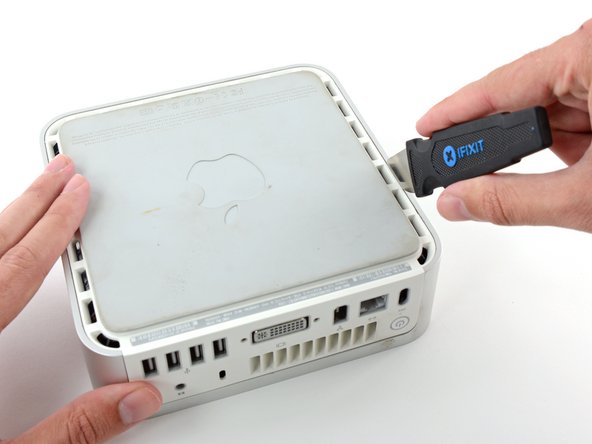
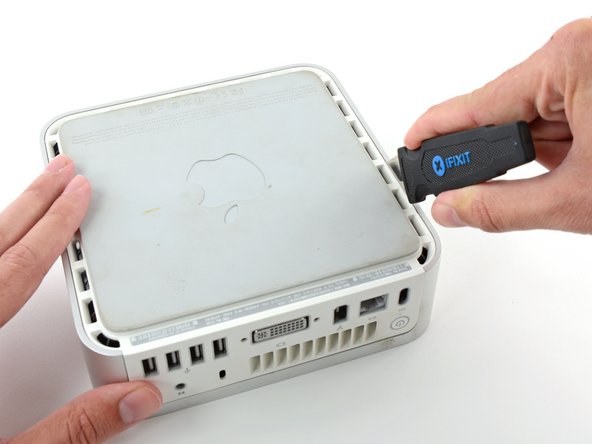




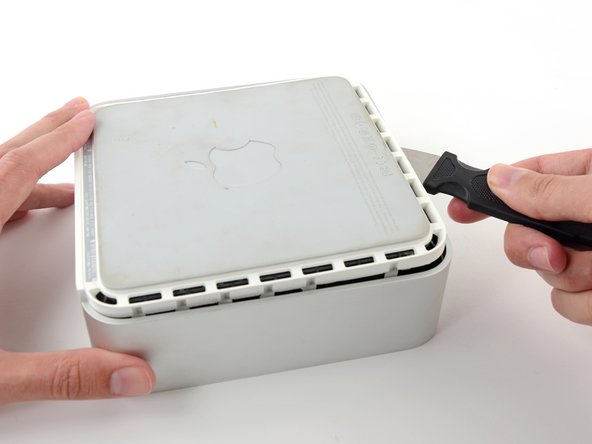


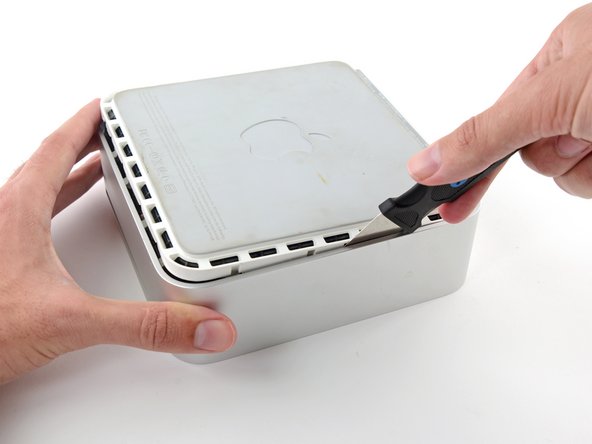





























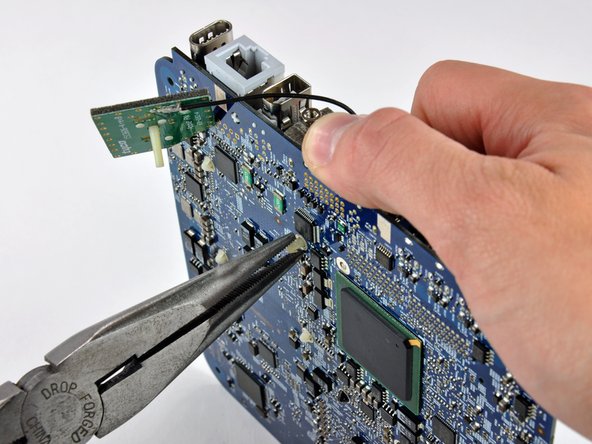




















A spackle knife makes these steps go much faster.
jouniseppanen - Antwort
A double sided letter opener or a thin non-serrated butter knife will suffice.
To prenent cosmetic blemishes, place a matchbook cover or similar thin cardboard on the outer perimeter under the “jimmy”.
Mike - Antwort